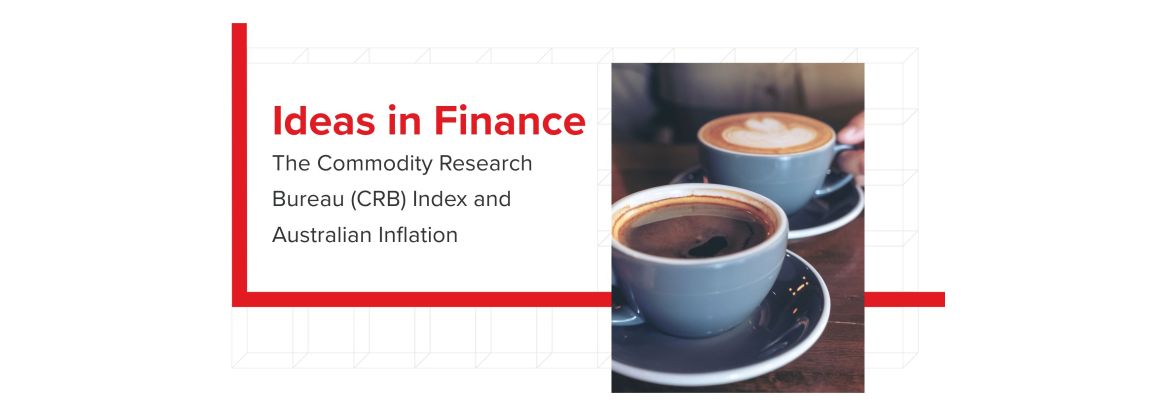The Commodity Research Bureau (CRB) Index and Australian Inflation
For decades, the CRB Index has tracked the price of a selection of “core” commodities. These are: Aluminium, Cocoa, Coffee, Copper, Corn, Cotton, Crude Oil, Gold, Heating Oil, Lean Hogs, Live Cattle, Natural Gas, Nickel, Orange Juice, RBOB Gasoline, Silver, Soybeans, Sugar, and Wheat. Like all price indexes, the index reflects the ups and downs in the price of this basket of commodities. Also like all price indexes, the weightings are important. The commodities in the CRB index are arranged in 4 groups, with different weightings: Energy: 39%, Agriculture: 41%, Precious Metals: 7%, Base/Industrial Metals: 13%. As such, the ups and downs in the index are most sensitive to changes in energy and agriculture prices predominantly.
Probably not too many people have heard of the CRB but it’s getting some attention on X in early 2025 because the CRB Index is soaring. It currently (January 30) stands at 370. This is the highest it has been since 2008 when it hit an all-time high of over 450.
You might have heard some vague reports about the price of coffee or the price of chocolate. More importantly, you might have seen the prices down at the shops. The price of a 1kg bag of ground coffee seems to me to have reached a very high level. Before I blame the supermarkets or the companies that roasted and bagged the coffee, let’s have a look at the raw price. That is, the price that the producers have to pay on the world market. Currently, the price of coffee is USD3.30 per pound or around USD7.30 per kilogram. That’s the raw beans. And that price is the highest it has ever been (!) Ever. With the AUD at 0.62USD, the AUD price of raw coffee is nearly $12 per kilo. That’s before the shipping, the bagging, the labelling, the transporting, the stocking of the shelves, etc. etc. If you can find a bag at, say $25/kg, you are paying $13 for everyone involved after the point at which the coffee was harvested: the guy who stocked the shelf, the share of the cost of keeping the lights on at the supermarket, the trucker, the people at the factory, the people who make the bags that it’s in…It must cost more than that, so the price is now more likely $40/kg.
What about chocolate (cocoa)? That’s even worse. Cocoa is traded in metric tonnes. At the moment, the price is $11,678 (USD) per metric tonne. Since the end of 2022, the price of cocoa has been on an almost vertical ascent. Up from around 2000 USD/MT. To put this in perspective, not only is the current price the highest ever, for much of the period between 1980 and 2020, the price was around $2,000/MT. There was a spike above $4,000 in the mid-to-late 1970s and another spike to around $4,000 in the early 2010s, but that was as high as it got. Now it’s closing in on 12,000 USD/MT.
There are some bright spots in the list of commodities included in the CRB. Soybeans are about $1,000 a bushel, down from nearly $1,800. Wheat is about $560 a bushel, down from over $1,000. Natural gas is about $3 per MMBtu (metric million British thermal unit) (1 MMBtu of gas = about 26 kg) down from over $9. Sugar is down to $19 per pound, from nearly $25. Crude oil is at $73 per barrel, down from over $100. But copper, gold, silver, orange juice, coffee and cocoa (as we discussed), are all up.
There’s another crimp that we need to discuss. Notice something about all the prices we just quoted? They are expressed in US dollars. So, we have to convert the prices into Australian dollars. As you might have noticed, the Australian dollar has been weak recently. It’s down from nearly USD0.80 in 2021 to USD0.62. That makes the price increases worse and diminishes the benefits we get from falling USD prices. Consider coffee. At $7 (USD) per kilo, that would have been $8.75 per kilo (AUD) if the AUD hadn’t depreciated so much. Instead, it’s $11.30 (AUD) per kilo. Consider wheat. At $1,000 (USD) per bushel and an AUD trading at 0.80USD, that’s $1,250 (AUD). Now wheat is $560 (USD) per bushel but the AUD is trading at 0.62USD. That makes the current wheat price $903 (AUD) per bushel. What has been an almost 50% decline in the wheat price in USD is only a 27% decline in AUD terms.
Conclusion: a weak Australian dollar contributes to inflation. Unfortunately, currencies tend to depreciate when interest rates go down. If you can earn a better return elsewhere, you sell up and move your money. This means that if the RBA does cut rates, it might weaken the AUD and make inflation worse. A strong currency stems from foreigners demanding your goods or seeing your country as a place to invest. For instance, if a Japanese company is going to invest $500 billion in America, they need to sell Yen and buy USD. What could foster a strong AUD? Policies that encourage foreign investment, policies that foster strong production of things people overseas want to buy, policies that make business conditions in Australia seem beautiful vis-à-vis competitors, like lower energy costs, policies that get out of the way (i.e., fewer policies) of innovations that would produce things Australia could sell. Like most things, it’s commonsense.
Activity
Find the prices of each of the components of the CRB and discuss their most important characteristics over the past 25 years.
Read more Ideas in Finance
Young Investors Seeking Dividends
The Velocity of Money and Central Bank Digital Currencies
Should You Want Interest Rates to Fall?
What’s Going on with the Chinese Economy?
Is it Negative Gearing or Monetised Housing?
Set the Interest Rate at Zero. Why Not?
When We Talk About Inflation, We Quote the CPI, But We Forget the PPI

